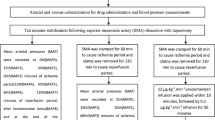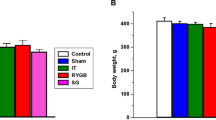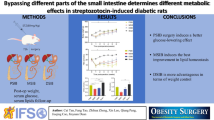Abstract
Anastomotic leakage is more frequently reported in colonic anastomoses. Ischemia reperfusion injury is one of the main reasons for anastomotic leakage. Simvastatin is known to prevent tissue damage induced by free oxygen radicals after ischemia reperfusion injury. The effect of simvastatin on colonic anastomosis impaired by ischemia reperfusion injury is investigated. Single layer, end-to-end colocolic anastomosis after 0.5-cm colon resection was performed in Wistar Albino rats. In Group 1 (control) (n = 10), colonic anastomosis without I-R was performed. In Group 2 (n = 10), the superior mesenteric artery was clamped for 10 min followed by 60 min of reperfusion after which resection anastomosis was performed. In Group 3 (n = 10), 10 mg/kg simvastatin was given by gavage for 7 days after I-R and resection anastomosis. In Group 4 (n = 10), the rats received 10 mg/kg simvastatin by gavage 7 days before and 7 days after ischemia reperfusion and surgery. All of the rats were sacrificed 8 days after surgery. Anastomotic bursting pressure and tissue hydroxyproline levels were measured. Postoperative administration of simvastatin restored the anastomotic bursting pressure and hydroxyproline levels to that of control group thus overcoming the effect of ischemia reperfusion injury. Simvastatin administered postoperatively in an experimental model of colonic resection anastomosis impaired by ischemia reperfusion injury increased anastomotic bursting pressures and tissue hydroxyproline levels. Further experimental and clinical studies will show whether administration of simvastatin will increase reliability of the anastomosis and decrease postoperative morbidity and mortality in colonic anastomosis after ischemia reperfusion injury.



Similar content being viewed by others

References
Soeters PB, de Zoete JP, Dejong CH, Williams NS, Baeten CG (2002) Colorectal surgery and anastomotic leakage. Dig Surg 19:150–155
Beck DE (2014) Colonic emergencies. In: Paterson-Brown S (ed) Core topics in general and emergency surgery, 5th edn. Saunders, Elsevier, Philadelphia, pp 179–203
Shogan BD, Carlisle EM, Alverdy JC, Umanskiy K (2013) Do we really know why colorectal anastomoses leak? J Gastrointest Surg 17:1698–1707. doi:10.1007/s11605-013-2227-0
Agren MS, Andersen TL, Mirastschijski U, Syk I, Schiødt CB, Surve V et al (2006) Action of matrix metalloproteinases at restricted sites in colon anastomosis repair: an immunohistochemical and biochemical study. Surgery 140:72–82
Shogan BD, Belogortseva N, Luong PM, Zaborin A, Lax S, Bethel C et al. (2015) Collagen degradation and MMP9 activation by Enterococcus faecalis contribute to intestinal anastomotic leak. Sci Transl Med 7:286ra68 doi: 10.1126/scitranslmed.3010658
Siemionow M, Arslan E (2004) Ischemia/reperfusion injury: a review in relation to free tissue transfers. Microsurgery 24:468–475
Goszcz K, Deakin SJ, Duthie GG, Stewart D, Leslie SJ, Megson IL (2015) Antioxidants in cardiovascular therapy: panacea or false hope? Front Cardiovasc Med 6;2:29 doi: 10.3389/fcvm.2015.00029
Johnson I, Spence MTZ (2010) The molecular probe handbook. A guide to fluorescent probes and labeling technologies. Life Technologies Corporation, Carlsbad, California
Maxwell SR, Lip GY (1997) Reperfusion injury: a review of the pathophysiology, clinical manifestations and therapeutic options. Int J Cardiol 58:95–117
Grootjans J, Lenaerts K, Derikx JP, Matthijsen RA, de Bruïne AP, van Bijnen AA et al (2010) Human intestinal ischemia-reperfusion-induced inflammation characterized: experiences from a new translational model. Am J Pathol 176:2283–2291. doi:10.2353/ajpath.2010.091069
Braskén P (1991) Healing of experimental colon anastomosis. Eur J Surg Supp 566:1–51
Czeiger D, Osyntsov A, Osyntsov L, Ball CG, Gigi R, Shaked G (2013) Examining the safety of colon anastomosis on a rat model of ischemia-reperfusion injury. World J Emerg Surg 8:24. doi:10.1186/1749-7922-8-24
Kuzu MA, Köksoy C, Kale IT, Tanik A, Terzi C, Elhan AH (1998) Reperfusion injury delays healing of intestinal anastomosis in a rat. Am J Surg 176:348–351
Guzel S, Sunamak O, AS A, Celik V, Ferahman M, Nuri MM et al (2006) Effects of hyperbaric oxygen and Pgg-glucan on ischemic colon anastomosis. World J Gastroenterol 12:1421–1425
Demiroğullari B, Sönmez K, Türkyilmaz Z, Ekingen G, Dursun A, Bor V et al (1998) Comparison of consequent small bowel anastomoses after transient ischemia: an experimental study in rats. J Pediatr Surg 33:91–93
Rugale C, Delbosc S, Mimran A, Jover B (2007) Simvastatin reverses target organ damage and oxidative stress in AngioTensin II hypertension: comparison with apocynin, tempol and hydralazine. J Cardiovasc Pharmacol 50:293–298
Karadeniz Cakmak G, Irkorucu O, Ucan BH, Emre AU, Bahadir B, Demirtas C et al (2009) Simvastatin improves wound strength after intestinal anastomosis in the rat. J Gastrointest Surg 13:1707–1716. doi:10.1007/s11605-009-0951-2
Rego AC, Araújo Filho I, Damasceno BP, Egito ES, Silveira IA, Brandão-Neto J et al (2007) Simvastatin improves the healing of infected skin wounds of rats. Acta Cir Bras 22(Suppl 1):57–63
Pruefer D, Makowski J, Schnell M, Buerke U, Dahm M, Oelert H et al (2002) Simvastatin inhibits inflammatory properties of Staphylococcus aureus alpha-toxin. Circulation 106:2104–2110
Calabrò P, Yeh ET (2005) The pleiotropic effects of statins. Curr Opin Cardiol 20:541–546
Blanco-Colio LM, Tuñón J, Martín-Ventura JL, Egido J (2003) Anti-inflammatory and immunomodulatory effects of statins. Kidney Int 63:12–23
Takenaka M, Hirade K, Tanabe K, Akamatsu S, Dohi S, Matsuno H et al (2003) Simvastatin stimulates VEGF release via p44/p42 MAP kinase in vascular smooth muscle cells. Biochem Biophys Res Commun 301:198–203
Ferri N, Colombo G, Ferrandi C, Raines EW, Levkau B, Corsini A (2007) Simvastatin reduces MMP1 expression in human smooth muscle cells cultured on polymerized collagen by inhibiting Rac1 activation. Arterioscler Thromb Vasc Biol 27:1043–1049. doi:10.1161/ATVBAHA.107.139881
Nomura S, Yoshimura K, Akiyama N, Mikamo A, Furutani A, Aoki H et al (2005) HMG-CoA reductase inhibitors reduce matrix metalloproteinase-9 activity in human varicose veins. Eur Surg Res 37:370–378. doi:10.1159/000090339
Demierre MF, Higgins PD, Gruber SB, Hawk E, Lippman SM (2005) Statins and cancer prevention. Nat Rev Cancer 5:930–942
Patrick L, Uzick M (2001) (2001) Cardiovascular disease: C-reactive protein and the inflammatory disease paradigm: HMG-CoA reductase inhibitors, alpha-tocopherol, red yeast rice, and olive oil polyphenols. A review of the literature. Altern Med Rev 6:248–271
Kagami S, Kanari H, Suto A, Fujiwara M, Ikeda K, Hirose K et al (2008) HMG-CoA reductase inhibitor simvastatin inhibits proinflammatory cytokine production from murine mast cells. Int Arch Allergy Immunol 146(Suppl 1):61–66. doi:10.1159/000126063
Corsini A, Maggi FM, Catapano AL (1995) Pharmacology of competitive inhibitors of HMG-CoA reductase. Pharmacol Res 31:9–27
Liao JK, Laufs U (2005) Pleiotropic effects of statins. Annu Rev Pharmacol Toxicol 45:89–118
Leung BP, Sattar N, Crilly A, Prach M, McCarey DW, Payne H et al (2003) A novel anti-inflammatory role for simvastatin in inflammatory arthritis. J Immunol 170:1524–1530
Solheim S, Seljeflot I, Arnesen H, Eritsland J, Eikvar L (2001) Reduced levels of TNF alpha in hypercholesterolemic individuals after treatment with pravastatin for 8 weeks. Atherosclerosis 157:411–415
Ferro D, Parrotto S, Basili S, Alessandri C, Violi F (2000) Simvastatin inhibits the monocyte expression of proinflammatory cytokines in patients with hypercholesterolemia. J Am Coll Cardiol 36:427–431
Lefer DJ (2002) Statins as potent antiinflammatory drugs. Circulation 106:2041–2042
Malyszko J, Malyszko JS, Hryszko T, Mysliwiec M (2003) Influence of simvastatin on aspects of thrombogenesis in CAPD patients. Perit Dial Int 23:260–266
Undas A, Brummel-Ziedins KE, Mann KG (2005) Statins and blood coagulation. Arterioscler Thromb Vasc Biol 25:287–294
Schmidt WM, Spiel AO, Jilma B, Wolzt M, Müller M (2008) In-vivo effects of simvastatin and rosuvastatin on global gene expression in peripheral blood leucocytes in a human inflammation model. Pharmacogenet Genomics 18:109–120. doi:10.1097/FPC.0b013e3282f44d81
Author information
Authors and Affiliations
Corresponding author
Rights and permissions
About this article
Cite this article
Akarsu, M., Saygun, O., Aydinuraz, K. et al. The Effects of Simvastatin on Ischemia Reperfusion Injury in an Experimental Colon Anastomosis Model. Indian J Surg 79, 390–395 (2017). https://doi.org/10.1007/s12262-016-1493-y
Received:
Accepted:
Published:
Issue Date:
DOI: https://doi.org/10.1007/s12262-016-1493-y



